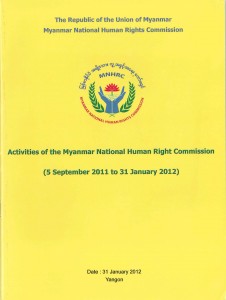Resources (827 found)
Activities of the Myanmar National Human Rights Commission (5 September 2011 to 31 January 2012)

This report details the activities of the Myanmar National Human Rights Commission since it’s creation on 5 September 2011 until 31 January 2012. The report includes details on the formation of the commission and its members, the mandate of the commission, the funding and the functioning of the commission. It also provides information on the handling of complaints, statements and other activities of the commission […]
• • •Analysis of EU Conclusions on Burma
On 23rd January 2012 the Foreign Affairs Council of the European Union met and adopted conclusions about the current situation in Burma, including suspending implementation […]
• • •Freedom of Expression and Opinion in Burma: Still a Long Way to Go
There have been a number of positive developments in Burma with respect to the freedom of expression and opinion over the course of 2011 including some reductions in the level of censorship of the press, the loosening of restrictions on access to the Internet, and the recent release of political prisoners. However, while the international community has been focused on these openings, hundreds more individuals remain in prison solely for expressing their opinions and numerous obstacles continue to make it difficult for journalists and ordinary citizens in Burma to exercise their rights to freedom of expression and opinion […]
• • •လယ္ယာေျမ အဓၶမသိမ္းယူမႈ မ်ားႏွင့္ေအာင္ပြဲအပိုင္းအစမ်ား
The Farmers’ Rights Defenders Network, a Burma-based rights group, has released a new publication documenting and recounting the courageous fight against land expropriation, intimidation and false prosecution of a group of rural villagers […]
ဤအစီရင္ခံစာသည္ မေကြးတိုင္းေဒသၾကီး၊ သရက္ခရိုင္၊ ကံမျမိဳ႕နယ္၊ စစၥရံေက်းရြာရွိ ရိုးသားစြာ လုပ္ကိုင္စားေသာက္ေသာ လယ္သမားမ်ား မတရားမႈမ်ားကို မိမိတို႕၏ စုစည္းမႈအားျဖင့္ တြန္းလွန္၍ တရားမွ်တမႈကို ရွာေဖြတိုက္ပြဲဝင္ခဲ့ၾကသည့္ ျဖစ္ရပ္တခုအား […]
• • •Coercion, Cruelty and Collateral Damage
An assessment of grave violations of children’s rights in conflict zones of southern Burma
This report is titled “Coercion, Cruelty and Collateral Damage: An assessment of grave violations of children’s rights in conflict zones of southern Burma”, and it is released by the Woman and Child Rights Project (WCRP), which was founded in 2000 by members of the Human Rights Foundation of Monland (HURFOM) to monitor and protect the rights of women and children in southern Burma. The 24-page report reveals that grave violations of children’s rights such as recruitment of child soldiers, killing and maiming, rape and sexual abuse, and forced labor continue to be committed by the Burmese military, despite the creation, by the United Nation Security Council (UNSC) resolution 1612 on Children and Armed Conflict passed in 2005 […]
• • •Burma’s NHRC: An Empty Gesture (updated version)
The international community should not welcome the creation of Burma’s NHRC until it complies with the Paris Principles
On 5 September, Burma’s regime announced that it had established a National Human Rights Commission (NHRC) charged with promoting and safeguarding the fundamental rights of citizens in accordance with the 2008 Constitution.
While the creation of a NHRC could be seen as a positive step, it should be welcomed with skepticism […]
• • •Preliminary Agreement between the Chin State Government and Chin National Front
An unofficial translation by Chinland Guardian of the preliminary peace agreement between the Chin National Front and the Chin State Government following peace talks in Hakha.
• •Leaflet on Crimes Against Humanity and War Crimes
This leaflet explains in very simple terms what are crimes against humanity and war crimes, including targeted attacks against civilians, deportation or forcible transfer of population, arbitrary imprisonment, torture, murder, rape or other forms of sexual violence, enslavement and enforced disappearance of persons.
Individuals and solidarity organizations are welcome to print and distribute this leaflet to raise public awareness about the ongoing crimes being committed in Burma […]
• • •Burma’s Democratic Facade: Human Right Abuses Continued
In Burma (also known as Myanmar), the new President Thein Sein (former Gen. Thein Sein) has attempted to move towards democratization or a democratic transition, by establishing a dialogue with pro-democracy leader Daw Aung San Suu Kyi and allowed her party […]
• • •All the information I’ve given you, I faced it myself: Rural testimony on abuse in eastern Burma since November 2010
Human rights abuses faced by ethnic communities across rural eastern Burma have continued since November 2010, and are consistent with patterns KHRG has documented since 1992. Drawing from a dataset of 1,270 oral testimonies, sets of images and documentation […]
• • •








 All posts
All posts